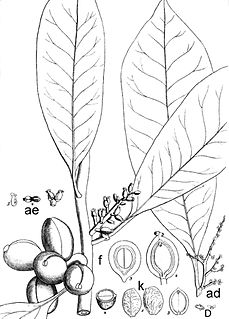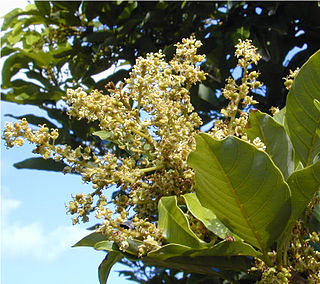
An inflorescence is a group or cluster of flowers arranged on a stem that is composed of a main branch or a complicated arrangement of branches. Morphologically, it is the modified part of the shoot of seed plants where flowers are formed on the axis of a plant. The modifications can involve the length and the nature of the internodes and the phyllotaxis, as well as variations in the proportions, compressions, swellings, adnations, connations and reduction of main and secondary axes. One can also define an inflorescence as the reproductive portion of a plant that bears a cluster of flowers in a specific pattern.

Cotinus, the smoketree or smoke bush, is a genus of seven species of flowering plants in the family Anacardiaceae, closely related to the sumacs (Rhus).

Didymeles is a genus of flowering plants. It is variously treated as the only genus of the family Didymelaceae — or in the family Buxaceae, as in the APG IV system.

Haptanthus is a monotypic genus containing the sole species Haptanthus hazlettii, a shrub or small tree known only from the locality of Matarras in the Arizona Municipality in Honduras. Its flowers are unique among the flowering plants. A single "female" (carpellate) flower has two branches on either side which carry "male" (staminate) flowers. The flowers are very simple, lacking obvious sepals or petals. The family placement of the genus has been uncertain, but based on molecular phylogenetic research, it is included in the family Buxaceae as of September 2014. Very few individuals have ever been found and its habitat is threatened by logging.

Nephelium ramboutan-ake, the pulasan, is a tropical fruit in the soapberry family Sapindaceae. It is closely related to the rambutan and sometimes confused with it. Other related soapberry family fruits include lychee and longan. Usually eaten fresh, it is sweeter than the rambutan and lychee, but very rare outside Southeast Asia.

Wachendorfia is a genus of perennial herbaceous plants that is assigned to the bloodroot family. The plants have a perennial rootstock with red sap. From the rootstock emerge lance- or line-shaped, sometime sickle-shaped, pleated, simple leaves set in a fan, that are flattened to create a left and right surface rather than an upper and lower surface. The leaves die when the seeds are shed in three of the species, and are perennial in one species. The rootstock also produces flowering stems annually that carry a panicle of zygomorphic, yellow or yellowish flowers in two distinct forms, one with the style and one stamen bent to the right and two stamens to the left, and vice versa. The fruit opens with three valves and each contains a single, hairy seed. All species only occur in the fynbos biome in the Cape provinces of South Africa.

Freycinetia arborea, ʻIeʻie, is a densely branched, brittle, woody climber in the family Pandanaceae, endemic to the Pacific Islands. ʻIeʻie is found in moist forest on the Hawaiian, Marquesas, Austral, Society, and Cook Islands. It grows into the forest canopy, attaching itself to a host tree using aerial roots. It may also grow as a sprawling tangle on the forest floor. The shiny green leaves have pointed ends and are spiny on the lower side of the midrib and along the edges. Leaves measure 40–80 centimetres (16–31 in) long and 1–3 centimetres (0.39–1.18 in) wide, and are spirally arranged around the ends of branches. Flowers form on spike-like inflorescences at the end of branches, and are either staminate or pistillate. Staminate spikes are yellowish-white and up to 10 centimetres (3.9 in) in length. Pistillate spikes are 3–4 centimetres (1.2–1.6 in) but elongate to 7.5–9.5 centimetres (3.0–3.7 in) once fruit are produced. Three to four spikes are surrounded by orange-salmon bracts. Fruit is 1 centimetre (0.39 in) long and contains many 1.5-millimetre (0.059 in) seeds. The bracts and fruit of the ʻieʻie were a favorite food of the ʻōʻū, an extinct Hawaiian honeycreeper that was formerly a principal seed dispersal vector for plants with small seeded, fleshy fruits in low elevation forests. It is also a favored food of the ʻalalā, which is currently extinct in the wild.

Licaria is a flowering plant genus in the family Lauraceae, endemic to Central America and South America. It is a Neotropical genus with near of 40 species.

Ornithostaphylos is a monotypic plant genus which contains the single species Ornithostaphylos oppositifolia, commonly known as the Baja California birdbush or Baja California manzanita. A large, evergreen shrub in the heather family, this species is near-endemic to northwestern Baja California, with a small population just north of the border in San Ysidro, California. It produces a much-branched inflorescence of white, urn-shaped flowers, and has leathery leaves that appear opposite or in whorls. These unique characteristics separate it from its close relatives in the region, which include manzanitas (Arctostaphylos), summer holly (Comarostaphylis) and mission manzanita (Xylococcus).

Symplocaceae is a family of flowering plants in the order Ericales, including two genera, Symplocos and Cordyloblaste, totalling about 260 known species. The common name for Symplocaceae is sweetleaf. Symplocaceae has a transpacific distribution that covers the Southeast United States, South America, Southeast Asia and Northern Australia. Plants in the family Symplocaceae are generally trees or shrubs, and are found in humid, tropical, montane forests within their range.

Oreomunnea mexicana is a species of plant in the family Juglandaceae, which grows in the tropical rain forests of Mexico, Guatemala, Nicaragua, Costa Rica, and Panama at altitudes from 1–1.7 km. Common names include guayabo amarillo and remiendo. The chromosome number is 2n = 32.
Alfaroa manningii, or gavilán colorado, is a valued lumber tree of the Walnut family endemic to the premontane Costa Rican rain forest. The specific epithet honors the American botanist Wayne Eyer Manning (1899–2004).

Pleroma heteromallum, synonyms including Tibouchina grandifolia and Tibouchina heteromalla, known by the common name silverleafed princess flower in English, is a species of evergreen flowering plant in the family Melastomataceae. It is native to French Guiana, Bolivia and Brazil.

Rhus aromatica, the fragrant sumac, is a deciduous shrub in the family Anacardiaceae native to North America. It is found in southern Canada and nearly all of the lower 48 states except peninsular Florida.

Toxicoscordion paniculatum is a species of flowering plant known by the common names foothill deathcamas, panicled death-camas, and sand-corn. It is widely distributed across much of the western United States, especially in the mountains and deserts of the Great Basin region west of the Rocky Mountains. It grows in many types of habitat, including sagebrush plateau, grasslands, forests, and woodlands, etc.
Harmsiopanax ingens of the Gensing, or Ivy Family (Araliaceae), is a very spiney palmlike mesocaul tree endemic to the montane rainforests of central New Guinea which bears a terminal rosette of deeply lobed, meter-wide dentate margined, peltate leaves on equally long petioles. It ultimately attains a height of eighteen meters, at which point it bears a huge panicle of flowers five meters high and equally wide; the largest above ground inflorescence of any dicot plant (although Caloncoba flagelliflora and Ficus geocarpa and Ficus unciata var. strigosa have larger subsurface panicles, each about nine meters in length. H. ingens' panicles are very unusual; the ultimate twigs being spikes each bearing about fifty tiny umbels, each umbel with 8 to 20 minute flowers. So panicle, spike and umbel are all represented in a single inflorescence. Harmsiopanax ingens is monocarpic, and again the largest such plant among dicots. H. ingens was discovered in 1973 by W. R. Philipson. Its native name is "makua".

Olyra latifolia, commonly known as carrycillo, is a species of bamboo in the grass family Poaceae. It occurs in Mexico, Central and South America, and in sub-Saharan Africa. It is a common species, up to 5 m (16 ft) tall, growing prolifically in rainforests, particularly near the margins.

Polyscias flynnii is a plant species endemic to the island of Kauai in Hawaii. It is rare, found only in one population covering about 1 km2 in the Kalalau Valley. It is regarded as threatened. It is threatened by feral goats and non-native plant species in its habitat. It was federally listed as an endangered species of the United States in 2010.

Macginitiea is an extinct genus in the sycamore or plane tree family ranging from the Late Paleocene to Late Eocene of North America, prominently known from the Clarno Formation of central Oregon. The genus is strictly used to describe leaves, but has been found in close association with other fossil platanoid organs, which collectively have been used for whole plant reconstructions. Macginitiea and its associated organs are important as together they comprise one of the most well-documented and ubiquitous fossil plants, particularly in the Paleogene of North America.

Lannea welwitschii is a species of tree in the family Anacardiaceae. It is native to the tropical rainforests of West and Central Africa. The timber is used to make furniture and utensils and for many other purposes, the fruits can be eaten, and the bark is used to produce a dye, for making rope and in traditional medicine.

















